Looking to create the perfect home for your scaly friend? In this article, we will guide you through the step-by-step process of setting up a reptile terrarium that will provide a comfortable and safe environment for your reptilian companion. From choosing the right enclosure and substrate to selecting the ideal temperature and lighting, we’ll cover all the essential aspects to ensure your reptile’s well-being. So, let’s get started and create a welcoming and enjoyable habitat for your reptile!
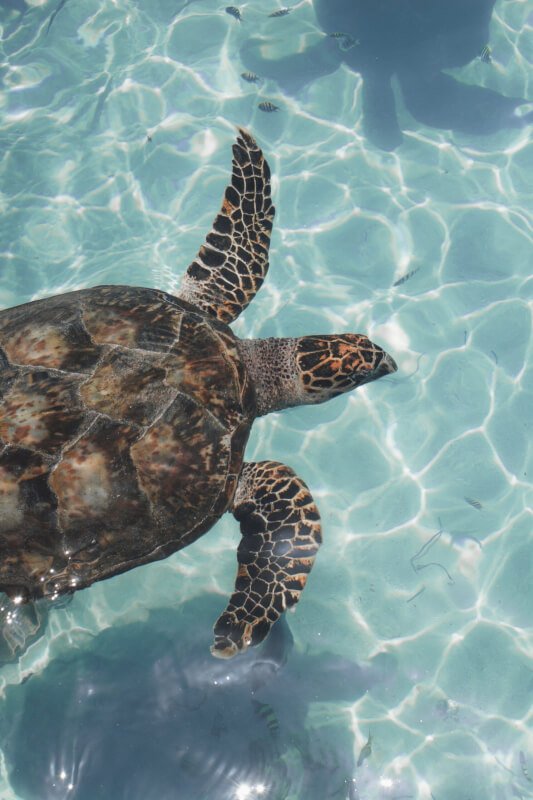
Choosing the Right Terrarium
Consider the Size of the Reptile
When choosing a terrarium for your reptile, it is vital to consider the size of the reptile itself. Reptiles vary in size, and each species has different space requirements. It is crucial to provide enough room for your reptile to move around comfortably and exhibit natural behaviors. Research the adult size of your reptile species and choose a terrarium that allows for growth and movement.
Select the Appropriate Material
Terrariums are available in various materials, including glass, plastic, and acrylic. Each material has its advantages and disadvantages, so it is essential to consider which one is most suitable for your reptile’s needs. Glass terrariums are popular as they provide good visibility and are easy to clean. Plastic and acrylic terrariums are lightweight, making them easier to transport. Consider the durability, ease of maintenance, and your reptile’s specific requirements when selecting the material for your terrarium.
Determine the Terrarium Type
There are different types of terrariums available, such as screen enclosures, glass front terrariums, and acrylic enclosures. The type of terrarium you choose should depend on your reptile’s species and environmental needs. Screen enclosures provide excellent ventilation, making them suitable for reptiles that require high humidity. Glass front terrariums are great for showcasing your reptile, as they offer optimal visibility. Acrylic enclosures provide insulation and are ideal for reptiles that require a particular temperature range. Consider your reptile’s preferences and requirements when determining the type of terrarium to provide them with a comfortable and suitable habitat.
Setting Up the Substrate
Understand the Reptile’s Natural Habitat
To create an ideal habitat for your reptile, it is crucial to understand their natural habitat. Research their native environment and try to mimic key elements in their terrarium setup. This includes replicating the type of substrate found in their natural habitat, as it plays a vital role in maintaining proper humidity levels and providing a comfortable surface for burrowing, climbing, or other natural behaviors.
Select the Suitable Substrate
There are several types of substrates available, including sand, soil, moss, bark, and coconut fiber. The choice of substrate depends on your reptile’s species and specific requirements. For desert-dwelling reptiles, sand or a sand-based substrate may be suitable. Forest-dwelling reptiles would benefit from a substrate that retains moisture, such as soil or coconut fiber. Consider your reptile’s natural habitat and choose a substrate that resembles it while catering to their needs for burrowing, nesting, or substrate-based activities.
Create the Right Thickness of Substrate
The depth of the substrate is essential, as it provides insulation and aids in maintaining proper humidity levels. The ideal substrate depth depends on the reptile species and their specific needs. In general, a substrate depth of 1.5 to 2 times the reptile’s body length is recommended. This allows your reptile to engage in natural behaviors, such as burying themselves or creating burrows. Ensure the substrate is deep enough to accommodate these behaviors while being shallow enough for your reptile to access other areas of the terrarium comfortably.
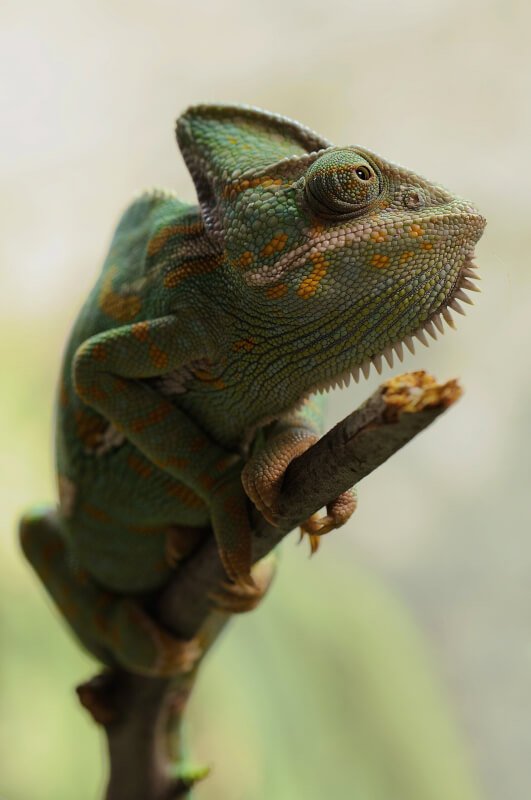
Providing Proper Lighting
Research the Reptile’s Lighting Needs
Lighting plays a crucial role in reptile terrariums, as it provides both heat and essential UVB radiation. Different reptile species require different lighting conditions to thrive. Some reptiles require both UVB and UVA radiation, while others may only need UVA. Research your reptile’s lighting needs to ensure you provide the appropriate lighting setup for their species. UVB lighting aids in vitamin D synthesis, which is vital for calcium metabolism and overall health in reptiles.
Provide Adequate UVB Lighting
UVB lighting should be provided through a high-quality UVB bulb designed specifically for reptile use. These bulbs emit the necessary UVB radiation, which helps prevent metabolic bone disease, essential for reptiles’ bone health. Position the UVB bulb at an appropriate distance from the basking spot to ensure your reptile receives the right amount of UVB radiation. Regularly replace the UVB bulb according to the manufacturer’s recommendations to maintain optimal output.
Include a Heat Source
Besides providing UVB lighting, reptiles also require an appropriate heat source to regulate their body temperature. This heat source can be a heat lamp or a ceramic heat emitter, depending on your reptile’s needs. The heat source should be positioned to create a temperature gradient within the terrarium, allowing your reptile to choose their desired temperature by moving between warm and cool areas. It is vital to monitor the terrarium’s temperature using a suitable thermometer to ensure it remains within the appropriate range for your reptile’s species.
Maintaining Optimal Temperature
Choose a Suitable Thermometer
To maintain optimal temperature in your reptile’s terrarium, it is crucial to use a reliable thermometer. Digital thermometers with remote probes are highly recommended, as they provide accurate readings and allow you to monitor the temperatures in various areas of the terrarium. Place the thermometer probes in both the warm and cool areas to ensure you have a complete understanding of the temperature gradient within the enclosure.
Create a Temperature Gradient
Reptiles are ectothermic animals, meaning they rely on external heat sources to regulate their body temperature. It is essential to create a temperature gradient within the terrarium, allowing your reptile to thermoregulate effectively. The warm side of the terrarium should have a basking spot with a temperature range specific to your reptile’s species. The cool side of the tank should provide a slightly lower and more comfortable temperature. This gradient allows your reptile to choose the temperature that suits their needs at any given time.
Ensure Proper Heating and Cooling
Maintaining proper heating and cooling in your reptile’s terrarium involves regulating the temperature to match their natural environment. This can be achieved through the use of heat lamps, heating pads, or ceramic heat emitters. Ensure the heating and cooling sources are functioning properly and are positioned strategically to create the desired temperature gradient. Regularly monitor the temperatures to ensure they remain within the appropriate range for your reptile’s species.
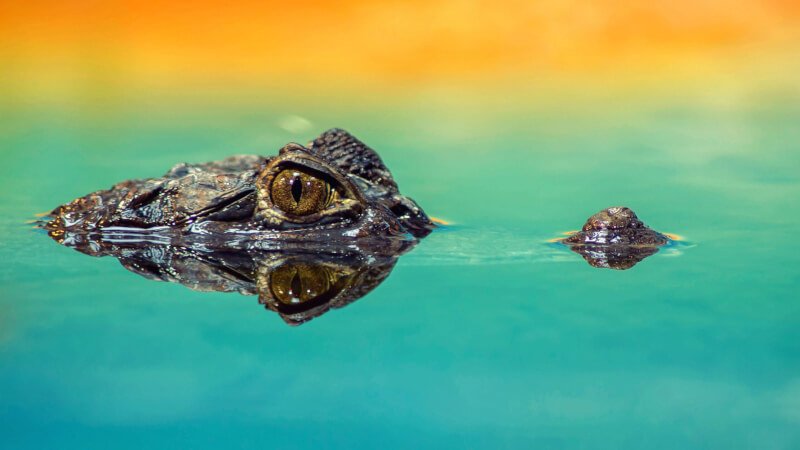
Installing a Heating Source
Consider the Reptile’s Thermal Requirements
Each reptile species has different thermal requirements, depending on their natural habitat and preferred temperature range. Research your reptile’s specific thermal needs to ensure you choose the appropriate heating source for their terrarium. Some reptiles prefer belly heat, while others may require overhead heat. Understanding your reptile’s thermal preferences is essential to providing a comfortable and suitable environment.
Choose Between Heat Mats, Heat Lamps, or Ceramic Heat Emitters
When it comes to heating sources for reptile terrariums, there are various options available, including heat mats, heat lamps, and ceramic heat emitters. Heat mats are placed under the terrarium substrate to provide belly heat, while heat lamps and ceramic heat emitters offer overhead heat. Consider your reptile’s thermal requirements and the temperature gradient you want to create when choosing between these heating sources.
Place the Heating Source Strategically
The placement of the heating source is critical to ensure the terrarium maintains the proper temperature gradient. It should be positioned in a way that provides the desired level of warmth for your reptile while allowing them to move away from the heat if necessary. Place the heat source within the terrarium according to your reptile’s thermal preferences and adjust as needed to maintain the correct temperature range.
Creating a Hiding Spot
Provide Multiple Hiding Options
Reptiles, like many animals, need a sense of security and privacy. Providing multiple hiding spots within the terrarium gives your reptile the opportunity to retreat and feel safe. Hiding spots can be created using various materials such as rocks, logs, or commercially available reptile hides. Place hiding spots in different areas of the terrarium to offer options for your reptile to choose from, replicating their natural behavior in the wild.
Use Natural Materials for Hiding Spots
Using natural materials, such as rocks or driftwood, for hiding spots not only provides a more realistic and aesthetically pleasing environment but also offers additional benefits. Natural materials can help retain heat and provide surfaces for your reptile to bask on or climb. Ensure the materials used are safe and non-toxic for your reptile, as some rocks or wood may release harmful substances when exposed to humidity or higher temperatures.
Consider Different Levels
Incorporating different levels within the terrarium, such as branches or platforms, can provide additional hiding options for your reptile. This allows them to explore their environment vertically and utilize all areas of the terrarium. By adding different levels, your reptile can engage in natural behaviors like climbing or basking at different heights. Consider the size and strength of your reptile when selecting and positioning these elements to ensure they can support their weight safely.
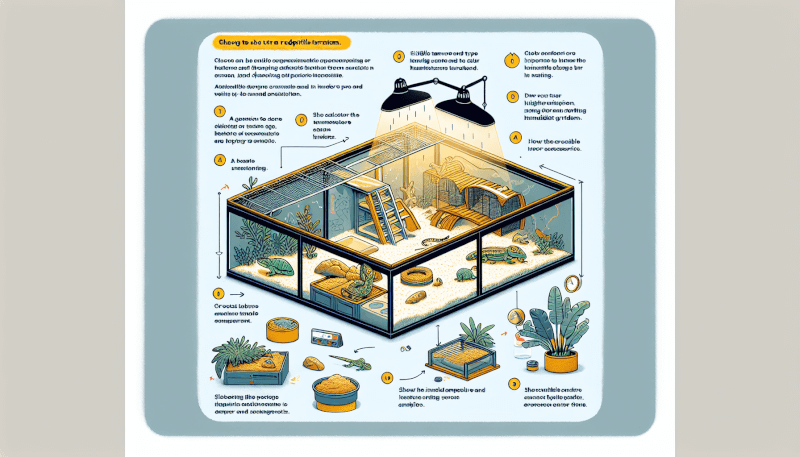
Adding Decorations
Select Safe and Non-Toxic Decorations
When adding decorations to your reptile’s terrarium, it is crucial to choose items that are safe and non-toxic. Reptiles may interact with their environment by climbing, exploring, or occasionally tasting elements within the terrarium. Select decorations made from natural materials, free from paints or coatings that may be harmful when ingested. Avoid using decorations with sharp edges or small pieces that your reptile can swallow or get injured on.
Incorporate Natural Elements
Reptiles thrive in environments that mimic their natural habitats. Incorporating natural elements like rocks, logs, branches, or plants can greatly enhance their terrarium experience. These elements provide additional climbing surfaces, basking spots, and hiding places, making your reptile’s habitat more stimulating and enriching. Ensure the natural elements are thoroughly cleaned and free from any chemicals or parasites before introducing them to the terrarium.
Create an Enriching Environment
Adding decorations not only enhances the aesthetics of the terrarium but also provides enrichment for your reptile. Enrichment involves creating a mentally stimulating and physically engaging environment for your reptile to explore and interact with. Incorporate elements such as tunnels, additional branches, or puzzle feeders to encourage natural behaviors. Regularly change and rearrange decorations to provide novelty and prevent boredom.
Installing the Water Dish
Determine the Reptile’s Hydration Needs
Water plays a crucial role in a reptile’s overall health and well-being. Different reptile species have varying hydration needs, with some requiring a constant source of water and others needing occasional misting or soaking. Research your reptile’s specific hydration requirements to determine the type of water dish and the frequency of water changes or misting necessary for their terrarium.
Choose the Appropriate Water Dish
The water dish in your reptile’s terrarium should be appropriate for their size and species. Select a shallow dish that allows easy access for drinking and soaking. Avoid using water dishes that are too deep, as they might pose a drowning risk for smaller reptiles. It is crucial to clean and refill the water dish regularly to ensure a clean and safe water source for your reptile.
Optimize Placement and Accessibility
Place the water dish in an easily accessible location within the terrarium, away from heat sources or direct sunlight. This prevents the water from becoming excessively warm and ensures your reptile can hydrate without the risk of overheating. Additionally, monitor the water dish’s cleanliness to remove any debris or feces that may contaminate the water.
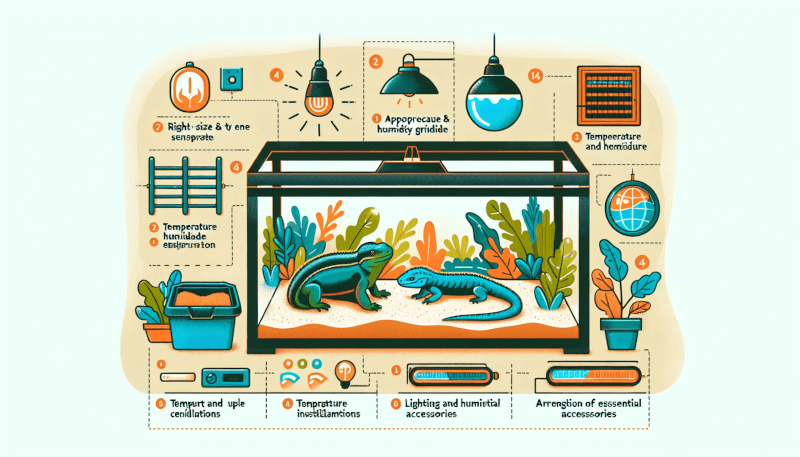
Monitoring and Maintaining Humidity
Research the Suitable Humidity Range
Different reptiles have varying humidity requirements, depending on their natural habitat and species. Research your reptile’s specific humidity needs to ensure their terrarium maintains the appropriate humidity range. This information will guide you in creating the ideal humidity level, preventing respiratory issues and promoting proper shedding.
Use a Hygrometer to Monitor Humidity Levels
To maintain the optimal humidity range, it is essential to monitor humidity levels within the terrarium. Use a hygrometer, a device specifically designed to measure humidity, to ensure the humidity stays within the desired range for your reptile’s species. Regularly check the hygrometer and make adjustments as needed, such as misting the terrarium or using a humidifier, to maintain the appropriate humidity levels.
Provide Proper Ventilation
While maintaining humidity is important, proper ventilation is equally crucial to avoid stagnant or excessively moist air. The terrarium should have sufficient airflow to prevent the growth of mold or bacteria. Regularly open the terrarium for fresh air exchange, and ensure any ventilation system or screen enclosures are clean and free from obstructions. Finding the right balance between humidity and ventilation is key to creating a healthy and comfortable environment for your reptile.
Establishing a Feeding Routine
Learn the Reptile’s Dietary Requirements
Reptiles have specific dietary requirements based on their species and natural diet. It is crucial to research and understand your reptile’s specific dietary needs. This includes determining whether they are carnivorous, herbivorous, or omnivorous and the appropriate food items to provide them. Providing a balanced and nutritionally complete diet is vital for your reptile’s overall health and well-being.
Choose the Right Food Items
Once you have identified your reptile’s dietary requirements, ensure you select appropriate food items that meet their nutritional needs. Live insects, vegetables, fruits, or commercial reptile diets can be suitable options, depending on your reptile’s species. It is crucial to source high-quality and properly sized food items that are safe for your reptile to consume. Consult with a veterinarian or reptile specialist for guidance on the best food items for your reptile.
Establish a Consistent Feeding Schedule
Reptiles benefit from a consistent feeding schedule that mimics their natural feeding patterns. Establish a feeding routine based on your reptile’s species and their specific requirements. Some reptiles require daily feedings, while others may only need to be fed every few days or weeks. Monitor your reptile’s weight and adjust the feeding schedule accordingly to ensure they maintain a healthy body condition.
In conclusion, setting up a reptile terrarium involves careful consideration of various factors to ensure your reptile’s well-being and happiness. By choosing the right terrarium size, material, and type, providing appropriate lighting, temperature, and humidity, and creating a stimulating environment with hiding spots, decorations, and proper feeding routines, you can create a comfortable and suitable habitat for your reptile. Remember to research your reptile’s specific needs and consult with experts to ensure you provide the best care possible. With a well-designed terrarium, your reptile can thrive and enjoy a fulfilling life in their new home.


